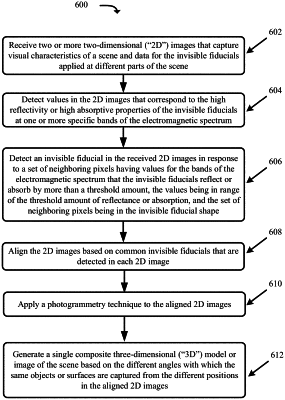| CPC G06T 5/50 (2013.01) [G06T 7/50 (2017.01); G06T 7/90 (2017.01); G06T 17/00 (2013.01); G06V 10/245 (2022.01); G06V 10/507 (2022.01); G06T 2207/10024 (2013.01); G06T 2207/10048 (2013.01); G06T 2207/20221 (2013.01); G06T 2207/30204 (2013.01)] | 20 Claims |

|
1. A method comprising:
applying an invisible fiducial with a specific shape to an outer surface of a particular object, wherein the invisible fiducial transparently changes reflectivity of the outer surface with the applied invisible fiducial in a specific wavelength that does not interfere with a capture of positions or visible color characteristics in a set of other wavelengths across the outer surface;
performing a first capture that measures a plurality of wavelengths reflected by the outer surface to a first position and a second capture that measures the plurality of wavelengths reflected by the outer surface to a second position, wherein the plurality of wavelengths comprises the specific wavelength and the set of other wavelengths, wherein the first capture comprises a first set of values measuring the specific wavelength reflecting off the outer surface to the first position and a second set of values representing a first set of positions or visible color characteristics of the outer surface based on the set of other wavelengths reflecting off the outer surface to the first position, and wherein the second capture comprises a third set of values measuring the specific wavelength reflecting off the outer surface to the second position and a fourth set of values representing a second set of positions or visible color characteristics of the outer surface based on the set of other wavelengths reflecting off the outer surface to the second position;
detecting a first position of the invisible fiducial in the first capture based on one or more values of the first set of values measured across the specific wavelength that satisfy an expected range of reflectivity in the specific wavelength associated with the invisible fiducial and that form the specific shape of the invisible fiducial;
detecting a second position of the invisible fiducial in the second capture based on one or more values of the third set of values measured across the specific wavelength that satisfy the expected range of reflectivity in the specific wavelength and that form the specific shape of the invisible fiducial;
aligning the first capture with the second capture until the invisible fiducial detected at the first position in the first capture has a same size, orientation, and position as the invisible fiducial detected at the second position in the second capture; and
generating a three-dimensional (“3D”) model of the particular object based on a photogrammetry modeling of the first capture and the second capture after said aligning, wherein the photogrammetry modeling comprises defining a 3D representation of the outer surface of the particular object in the 3D model by merging the second set of values from the first capture with the fourth set of values from the second capture while removing the first set of values and the third set of values from the 3D representation so as to not affect the visible color characteristics of the outer surface in the 3D model.
|